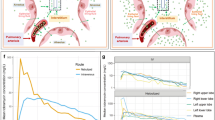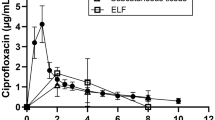Abstract
In vivo measurement of concentrations of drugs and endogenous substances at the site of action has become a primary focus of research. In this context the minimal invasive microdialysis (MD) technique has been increasingly employed for the determination of pharmacokinetics in lung. Although lung MD is frequently employed to investigate various drugs and endogenous substances, the majority of lung MD studies were performed to determine the pharmacokinetic profile of antimicrobials that can be related to the importance of respiratory tract infections. For the lower respiratory tract various methods, such as surgical collection of whole lung tissue and bonchoalveolar lavage (BAL), are currently available for the determination of pharmacokinetics of antimicrobials. Head-to-head comparison of pharmacokinetics of antibiotics in lung revealed high differences between MD and conventional methods. MD might be regarded as a more advantageous approach because of its higher anatomical resolution and the ability to obtain dynamic time-vs-concentration profiles within one subject. However, due to ethical objections lung MD is limited to animals or patients undergoing elective thoracic surgery. From these studies it was speculated that the concentrations in healthy lung tissue may be predicted reasonably by the measurement of concentrations in skeletal muscle tissue. However, until now this was only demonstrated for β-lactam antibiotics and needs to be confirmed for other classes of antimicrobials. In conclusion, the present review shows that MD is a promising method for the determination of antimicrobials in the lung, but might also be applicable for measuring a wide range of other drugs and for the investigation of metabolism in the lower respiratory tract.
Similar content being viewed by others
References
Muller M. Microdialysis in clinical drug delivery studies.Adv Drug Deliv Rev. 2000;45:255–269.
de la Pena A, Liu P, Derendorf H. Microdialysis in peripheral tissues.Adv Drug Deliv Rev. 2000;45:189–216.
Ungerstedt U. Microdialysis—principles and applications for studies in animals and man.J Intern Med. 1991;230:365–373.
Muller M, Haag O, Burgdorff T, et al. Characterization of peripheral-compartment kinetics of antibiotics by in vivo microdialysis in humans.Antimicrob Agents Chemother. 1996;40:2703–2709.
Joukhadar, C, Derendorf H, Muller M. Microdialysis. A novel tool for clinical studies of anti-infective agents.Eur J Clin Pharmacol. 2001;57:211–219.
Chalmers GW, Thomson L, Macleod KJ, et al. Endothelin-1 levels in induced sputum samples from asthmatic and normal subjects.Thorax. 1997;52:625–627.
Conte JEJr, Golden JA, Kipps J, McIver M, Zurlinden E. Intrapulmonary pharmacokinetics and pharmacodynamics of itraconazole and 14-hydroxyitraconazole at steady state.Antimicrob Agents Chemother. 2004;48:3823–3827.
Ingvast-Larsson C, Appelgren LE, Nyman G. Distribution studies of theophylline: microdialysis in rat and horse and whole body autoradiography in rat.J Vet Pharmacol Ther. 1992;15:386–394.
Tomaselli F, Dittrich P, Maier A, et al. Penetration of piperacillin and tazobactam into pneumonic human lung tissue measured by in vivo microdialysis.Br J Clin Pharmacol. 2003;55:620–624.
Herkner H, Muller MR, Kreischitz N, et al. Closed-chest microdialysis to measure antibiotic penetration into human lung tissue.Am J Respir Crit Care Med. 2002;165:273–276.
Tomaselli F, Maier A, Matzi V, Smolle-Juttner FM, Dittrich P. Penetration of meropenem into pneum onic humanlung tissue as measured by in vivo microdialysis.Antimicrob Agents Chemother. 2004;48:2228–2232.
Liu P, Muller M, Grant M, Webb AI, Obermann B, Derendorf H. Interstitial tissue concentrations of cefpodoxime.J Antimicrob Chemother. 2002;50:19–22.
Grubb BR, Jones JH, Boucher RC Mucociliary transport determined by in vivo microdialysis in the airways of normal and CF mice.Am J Physiol Lung Cell Mol Physiol. 2004; 286:L588-L595.
Eichler W, Bechtel MJ, Klaus S, et al. Na/H+ exchange inhibitor cariporide: effects on respiratory dysfunction after cardiopulmonary bypass.Perfusion.. 2004;19:33–40.
Larsson CI. The use of an “internal standard” for control of the recovery in microdialysis.Life Sci. 1991;49:PL73-PL78.
De La Pena A, Dalla Costa T, Talton JD, et al. Penetration of cefaclor into the interstitial space fluid of skeletal muscle and lung tissue in rats.Pharm Res. 2001;18:1310–1314.
Eisenberg EJ, Conzentino P, Eickhoff WM, Cundy KC. Pharmacokinetic measurement of drugs in lung epithelial lining fluid by microdialysis: aminoglycoside antibiotics in rat bronchi.J Pharmacol Toxicol Methods. 1993;29:93–98.
DeGuchi Y, Terasaki T, Yamada H, Tsuji A. An application of microdialysis to drug tissue distribution study: in vivo evidence for free-ligand hypothesis and tissue binding of beta-lactam antibiotics in interstitial fluids.J Pharmacobiodyn. 1992;15:79–89.
Vincent JL, Bihari DJ, Suter PM, et al. The prevalence of nosocomial infection in intensive care units in Europe. Results of the European, Prevalence of Infection in Intensive Care (EPIC) Study. EPIC International Advisory Committee,.JAMA. 1995;274:639–644.
Bartlett JG Mundy LM. Community-acquired pneumonia.N Engl J Med. 1995;333:1618–1624.
Zeitlinger MA, Dehghanyar P, Mayer BX, et al. Relevance of soft-tissue penetration by levofloxacin for target site bacteria killing in patients with sepsis.Antimicrob Agents Chemother. 2003;47:3548–3553.
Joukhadar C, Frossard M, Mayer BX, et al. Impaired target site penetration of beta-lactams may account for therapeutic failure in patients with septic shock.Crit Care Med. 2001;29:385–391.
Lambert HP. Clinical significance of tissue penetration of antibiotics in the respiratory tract.Scand J Infect Dis Suppl. 1978;14:262–266.
Craig WA. Pharmacokinetic/pharmacodynamic parameters: rationale for antibacterial dosing of mice and men.Clin Infect Dis. 1998;26:1–12.
Drusano GL, Craig WA. Relevance of pharmacokinetics and pharmacodynamics in the selection of antibiotics for respiratory tract infections.J Chemother. 1997;9:38–44.
Schentag JJ. Correlation of pharmacokinetic parameters to efficacy of antibiotics: relationships between serum concentrations MIC values, and bacterial eradication in patients with gram-negative pneumonia.Scand J Infect Dis Suppl. 1990;74:218–234.
EMEA. Points to consider on pharmacokinetics and pharmacodynamics in the development of antibacteiral medicinal products. Available at: http://www.emea.en.int/pdfs/human/ewp/265599en.pdf. Accessed October 11, 2005.
FDA. Guidance for Industry. Developing antimicrobial drugs—general considerations for clinical trials. Available at: http://www.fda.gov/cder/guidance/2580dft.pdf. Accessed October 11, 2005.
Bergogne-Berezin E. New concepts in the pulmonary disposition of antibiotics.Pulm Pharmacol. 1995;8:65–81.
Gail DB, Lenfant CJ. Cells of the lung: biology and clinical implications.Am Rev Respir Dis. 1983;127:366–387.
Marlin GE, Burgess KR, burgoyne J, Funnell GR, Guinness MD. Penetration of piperacillin into bronchial mucosa and sputum.Thorax. 1981;36:774–780.
Klastersky J, Thys JP, Mombelli G. Comparative studies of intermittent and continuous administration of aminogly cosides in the treatment of bronchopulmonary infectiosn due to gram-negative bacteria.Rev Infect Dis. 1981;3:74–83.
Brun Y, Forey F, Gamondes JP, Tebib A, Brune J, Fleurette J. Levels of erythromycin in pulmonary tissue and bronchial mucus compared to those of amoxycillin.J Antimicrob Chemother. 1981;8:459–466.
Jehl F, Muller-Serieys C, de Larminat V, Monteil H, Bergogne-Berezin E. Penetration of piperacillin-tazobactam, into bronchial secretions after multiple doses to intensive care patients.Antimicrob Agents Chemother. 1994;38:2780–2784.
Bergogne-Berezin E, Muller-Serieys C, Aubier M, Dombret MC. Concentration of meropenem in serum and in bronchial secretions in patients undergoing fibreoptic bronchoscopy.Eur J Clin Pharmacol. 1994;46:87–88. Erratum in. Eur J Clin Pharmacol. 1994;46;282.
Cole DR, Pung J. Penetration of cefazolin into pleural fluid.Antimicrob Agents Chemother. 1977;11:1033–1035.
Byl B, Jacobs F, Roucloux I, de Franquen P, Cappello M, Thys JP. Penetration of meropenem in lung, bronchial mucosa, and pleural tissues.Antimicrob Agents Chemother. 1999; 43:681–682.
Reynolds HY. Use of bronchoalveolar lavage in humans—past necessity and future imperative.Lung.. 2000;178:271–293.
Valcke Y, Pauwels R, Van der Straeten M. The penetration of aminoglycosides into the alveolar lining fluid of rats. The effect of airway inflammation.Am Rev Respir Dis. 1990;142:1099–1103.
Panteix G, Harf R, Desnottes JF, et al. Accumulation of pefloxacin in the lower respiratory tract demonstrated by bronchoalveolar lavage.J Antimicrob Chemother. 1994;33:979–985.
Allegranzi B, Cazzadori A, Di Perri G, et al Concentrations of single-dose meropenem (1 g iv) in bronchoalveolar lavage and epithelial lining fluid.J Antimicrob Chemother. 2000;46:319–322.
Harf R, Panteix G, Desnottes JF, Diallo N, Leclercq M. Spiramycin uptake by alveolar macrophages.J Antimicrob Chemother. 1988;22:135–140.
Le Conte P, Potel G, Peltier P, et al. Lung distribution and pharmacokinetics of aerosolized tobramycin.Am Rev. Respir Dis. 1993;147:1279–1282.
Wollmer P, Pride NB, Rhodes CG, et al. Measurement of pulmonary erythromycin concentration in patients with lobar pneumonia by means of positron tomography.Lancet. 1982;320:1361–1364.
Allegranzi B. Concentrations of single-dose meropenem (1 g iv) in bronchoalveolar lavage and epithelial lining fluid.J Antimicrob Chemother. 2000;46:319–322.
Baldwin DR, Honeybourne D, Wise R. Pulmonary disposition of antimicrobial agents: in vivo observations and clinical relevance.Antimicrob Agents Chemother. 1992;36:1176–1180.
Decre D, Bergogne-Berezin E. Pharmacokinetics of quinolones with special reference to the respiratory tree.J Antimicrob Chemother. 1993;31:331–343.
Braude AC, Hornstein A, Klein M, Vas S, Rebuck AS. Pulmonary disposition of to bramycin.Am Rev Respir Dis 1983;127:563–565.
Kunin CM. Clinical significance of protein binding of the penicillins.Ann N Y Acad Sci. 1967;145:282–290.
Tulkens PM. Intracellular pharmacokinetics and localization of antibiotics as predictors of their efficacy against intraphagocytic infections.Scand J Infect Dis Suppl. 1990;74:209–217.
Boselli E Breilh D Cannesson M, et al. Steady-state plasma and intrapulmonary concentrations of piperacillin/tazobactam 4 g/0.5 g administered to critically ill patients with severe nosocomial pneumonia.Intensive Care Med. 2004;30:976–979.
Nix DE, Goodwin SD, Peloquin CA, Rotella DL, Schentag JJ. Antibiotic tissue penetration and its relevance: impact of tissue penetration on infection response.Antimicrob Agents Chemother. 1991;35:1953–1959.
Zeitlinger M, Graninger W, Joukhadar C. Pharmacokinetics of the macrolides azithromycin, clarithromycin and roxithromycin in plasma and tissue—are there significant differences? In:Wien Klin Wochenschr. vol. 11–12a. 2004:18–24.
Rodvold KA, Gotfried MH, Danziger LH, Servi RJ. Intrapulmonary steady-state concentrations of clarithromycin and azithromycin in healthy adult volunteers.Antimicrob Agents Chemother. 1997;41:1399–1402.
Poulin P, Theil FP. A priori prediction of tissue: plasma partition coefficients of drugs to facilitate the use of physiologically-based pharmacokinetic models in drug discovery.J Pharm Sci. 2000;89:16–35.
Joukhadar C, Klein N, Mayer BX, et al. Plasma and tissue pharmacokinetics of cefpirome in patients with sepsis.Crit Care Med. 2002;30:1478–1482.
Joukhadar, C, Stass H, Muller-Zellenberg U, et al. Penetration of moxifloxacin into healthy and inflamed subcutaneous adipose tissues in humansAntimicrob Agents Chemother. 2003;47:3099–3103.
LeBel M. Fluoroquinolones in the treatment of cystic fibrosis: a critical appraisal.Eur J Clin Microbiol Infect Dis 1991;10:316–324.
Mendelman PM, Smith AL, Levy J, Weber A, Ramsey B, Davis RL. Aminoglycoside penetration, inactivation, and efficacy in cystic fibrosis sputum.Am Rev Respir Dis. 1985;132:761–765.
Barza M, Cuchural G. General principles of antibiotic tissue penetration.J Antimicrob Chemother. 1985;15:59–75.
Muller-Serieys C, Bancal C, Dombret MC, et al. Penetration of cefpodoxime proxetil in lung parenchyma and epithelial lining fluid of noninfected patients.Antimicrob Agents Chemother. 1992;36:2099–2103.
Prokesch RC, Hand WL. Antibiotic entry into human polymorphonuclear leukocytes.Antimicrob Agents Chemother. 1982;21:373–380.
Forsgren A, Bellahsene A. Antibiotic accumulation in human polymorphonuclear leucocytes and lymphocytes.Scand J Infect Dis Suppl. 1985;44:16–23.
Peck CC, Nichols AI, Baker J, Lenert LL, Ezra D. Clinical pharmacodynamics of theophylline.J Allergy Clin Immunol. 1985;76:292–297.
Devarajan PV, Sule PN, Parmar DV. Comparative pharmacodynamic.-pharmacokinetic correlation of oral sustained-release theophylline formulation in adult asthmatics.Drug Dev Ind Pharm. 1999;25:529–534.
Glynn-Barnhart A, Hill M, Szefler SJ. Sustained release theophylline preparations Practical recommendations for prescribing and therapeutic drug monitoring.Drugs. 1988;35:711–726.
Hook GE, Bend JR. Pulmonary metabolism of xenobiotics.Life Sci. 1976;18:279–290.
Robertson CS, Gopinath SP, Uzura M, Valadka AB, Goodman JC. Metabolic changes in the brain during transient ischemia measured with microdialysis.Neurol Res. 1998;20:S91-S94.
Frykholm P, Hillered L, Langstrom B, et al. Increase of interstitial glycerol reflects the degree of ischaemic brain damage: a PET and microdialysis study in a middle cerebral artery occulusion-reperfusion primate model.J Neurol Neurosurg Psychiatry. 2001;71:455–461.
Parkin M, Hopwood S, Jones DA, et al. Dynamic changes in brain glucose and lactate in pericontusional areas of the human cerebral cortex, monitored with rapid sampling on-line microdialysis: relationship with depolarisation-like events.J Cereb Blood Flow Metab. 2005;25:402–413.
Taggart DP, el-Fiky M, Carter R, Bowman A, Wheatley, DJ. Respiratory dysfunction after uncomplicated cardiopulmonary bypass.Ann Thorac Surg. 1993;56:1123–1128.
Theroux P, Chaitman BR, Danchin N, et al. Inhibition of the sodium-hydrogen exchanger with cariporide to prevent myocardial infarction in high-risk ischemic situations. Main results of the GUARDIAN trial. Guard during ischemia against necrosis (GUARDIAN) Investigators.Circulation. 2000;102:3032–3038.
Afzelius BA. A human syndrome caused by immotile cilia.Science. 1976;193:317–319.
Robinson M, Bye PT. Mucociliary clearance in cystic fibrosis.Pediatr Pulmonol. 2002;33:293–306.
Author information
Authors and Affiliations
Corresponding author
Additional information
Published: October 22, 2005
Rights and permissions
About this article
Cite this article
Zeitlinger, M., Müller, M. & Joukhadar, C. Lung microdialysis—A powerful tool for the determination of exogenous and endogenous compounds in the lower respiratory tract (mini-review). AAPS J 7, 62 (2005). https://doi.org/10.1208/aapsj070362
Received:
Accepted:
DOI: https://doi.org/10.1208/aapsj070362




